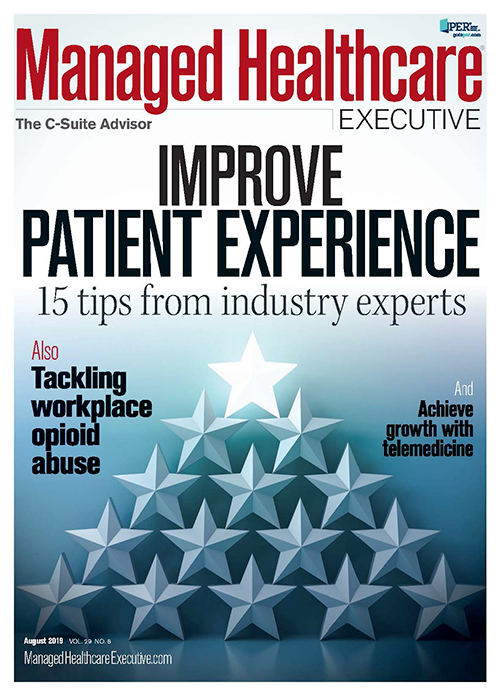New Report is Tackling Workplace Opioid Abuse
The first step to addressing opioid abuse for employers is to identify potential misuse and addiction.

Each year there are more than 17,000 deaths nationally from prescription opioid overdoses, according to the CDC. The National Safety Council reports that 75% of U.S. employers say their workplace has been directly affected by opioid usage but only 17% feel well prepared to deal with the issue.
In response to the local and national ongoing opioid epidemic, First Choice Health (FCH), a provider-owned health benefits company, which serves over 1 million people in Washington and the Northwest, wanted to do its part to help.
Launched on July 11, 2019, FCH’s Workforce Prescription Opioid Use Report, is offered free of charge to employers in the Puget Sound area with over 200 employees until Sept 15, 2019. The report will help identify high rates of opioid use, which can be associated with potential misuse and addiction among employees.
Once initiated, the employer will instruct their pharmacy benefits manager (PBM) to send their pharmacy claims to FCH to be analyzed. This extracted information will be de-identified with no personal health information and is completely HIPAA-compliant.
Related article: The Impact of Preoperative Opioid Use on Patient Outcomes
The program is a follow up to its recently-launched program tackling opioid abuse in the workplace.
“We are constantly innovating our application of data to help create healthier workforces, while responding to our society’s most serious health concerns,” says John W. Robinson, MD, chief medical officer, FCH. “Opioids are at the top of that list. We are implementing this workforce prescription opioid use report as a community service to help employers recognize if they have an opioid problem in their workforce.”
Robinson is a member of the Dr. Robert Bree Collaborative, which was established so that public and private healthcare stakeholders would have the opportunity to identify specific ways to improve healthcare quality, outcomes, and affordability in Washington State.
In 2017, the Bree Collaborative produced the Opioid Prescribing Metrics. This screening report uses four of the nine opioid prescribing metrics developed by the Bree Collaborative, a workgroup convened in 2017 to help implement opioid guidelines and standardize comparisons between populations to help implement opioid guidelines and standardize comparisons between populations.
Actuarial consulting firm Milliman participated in this project by verifying the analytic code used to compute the results for the report. (The report results will be strictly workforce aggregate, and there will not be any individual employee results.)
- Metric 1: Percentage of patients prescribed any opioid by age group
- Metric 2: Percentage of patients prescribed chronic opioids (60 days of opioids in one quarter)
- Metric 3: Percentage of patients prescribed chronic opioids and sedatives together
- Metric 4: Percentage of new member's day supply of first opioid prescription which are greater than 14 days
FCH’s previously announced Case Management program tackling opioid misuse and abuse uses the nine opioid prescribing metrics developed by The Bree Collaborative. FCH is already providing its clients with a comprehensive population health report to identify potential risks, with one high-risk group including anyone who has been prescribed opioids together with sedatives for more than 60 days within a three-month period, a potentially deadly combination.
Once those at risk have been identified, FCH’s medical and behavioral health case managers will reach out to the employees and confidentially discuss their prescription use and treatment options, which may include alternative pain management or counseling. The entire program is confidential but gives employers more tools to help employees in need without specifically identifying them.
“This program is aimed at reducing opioid misuse and abuse in the workplace, which can affect productivity, absenteeism, health, and safety,” Robinson says. “Following that launch, we started receiving inquiries from employers-who weren’t our clients-asking how they could get this report. That gave us the final push to launch this program in an effort to support our community. We created a simpler screening opioid use report that we could offer to community employers with at least 200 employees, which would only require pharmacy claims from the PBM. The results contain no employee names or identifying information.”
This model is applicable to any health plan or TPA, according to Robinson. To conduct this four-measure screening report on workforce prescription opioid use, FCH needs the health plan/TPA to provide a signed Data Use Agreement and the PBM to provide the de-identified pharmacy claims extract with just seven claim fields.
While this is a program for the Seattle region, it’s a unique initiative that could provide a blueprint for other health care organizations aiming to tackle this problem throughout the country, according to Robinson.
“Depending on the response from the community, this program could be rolled out to other communities and other states,” he says.

David Calabrese of OptumRx Talks New Role, Market Insulin Prices and Other Topics 'On His Mind'
April 13th 2023In this month’s episode of the "What's On Your Mind podcast," Peter Wehrwein, managing editor of MHE connects with the now Chief Clinical Officer of OptumRx Integrated Pharmacies, David Calabrese. In this conversation, David touches on his transition in January as OptumRx’s former chief pharmacy officer and market president of health plans and PBMs to his new role as Chief Clinical Officer where he now focuses more on things such as specialty pharmacy to home delivery — with an overall goal of creating whole-patient care. Throughout the conversation, Calabrese also touched on the market’s hot topic of insulin prices and behavioral health services within the OptumRx community, among other topics.
Listen
Upended: Can PBM Transparency Succeed?
March 6th 2024Simmering tensions in the pharmacy benefit management (PBM) industry have turned into fault lines. The PBMs challenging the "big three" have formed a trade association. Purchaser coalitions want change. The head of the industry's trade group says inherent marketplace friction has spilled over into political friction.
Read More
Briana Contreras, editor of Managed Healthcare Executive, spoke with Nancy Lurker, CEO and president of EyePoint Pharmaceuticals. Nancy shared a bit about EyePoint and how the organization’s innovative therapies are addressing patient needs through eye care, and most importantly, she addressed C-Suite positions like the CEO role. Nancy shared advice for those seeking to reach the CEO level, especially toward women in healthcare and other roles, and what it takes to run a biopharma company.
Listen
The deliberate disconnection of Change Healthcare to ring fence a cyberattack entered its seventh day today. Prescribers are finding ways to get pharmacy claims processed, and UnitedHealth Group says disruption to the dispensing of prescriptions has been minimal. But independent pharmacies want more information and protection from financial consequences from pharmacy benefit managers.
Read More